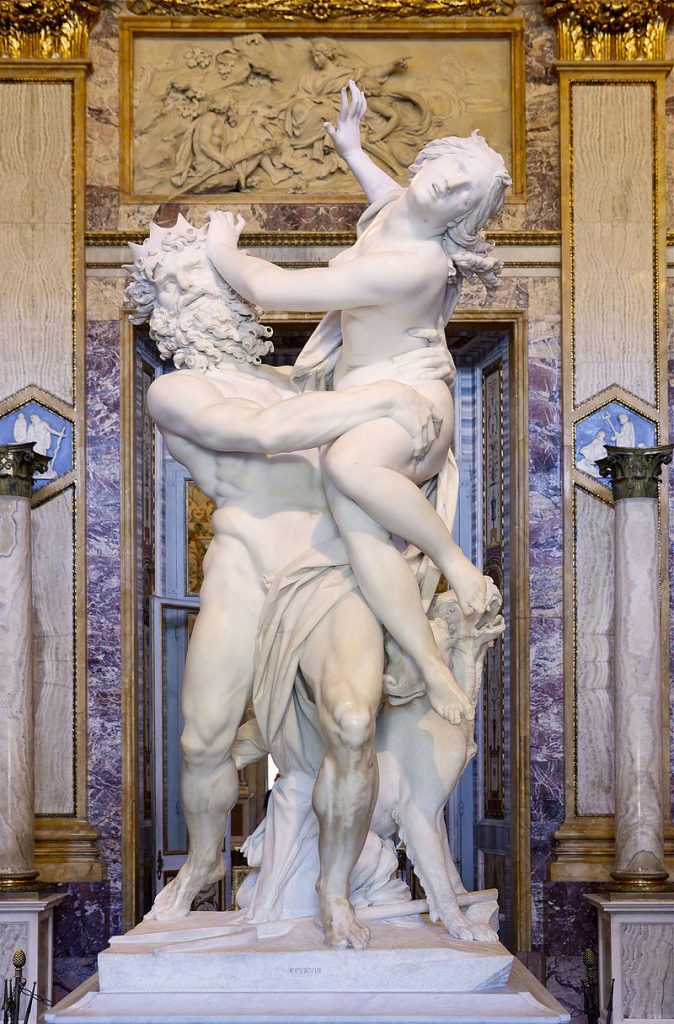
Gian Lorenzo Bernini’s “The Rape of Proserpina,” sculpted between 1621 and 1622, stands as a quintessential example of Baroque art from the 17th century. This masterpiece, located in the Borghese Gallery in Rome, captures the dynamism, emotional intensity, and technical virtuosity characteristic of Baroque sculpture.
- Dramatic Realism: Bernini excelled in conveying a sense of dramatic realism in his sculptures, and “The Rape of Proserpina” is no exception. The dynamic composition, with Pluto’s forceful grasp and Proserpina’s visceral reaction, creates a vivid and emotionally charged narrative.
- Emotional Intensity: Baroque art often sought to evoke strong emotions and engage the viewer on a visceral level. In this sculpture, Bernini masterfully conveys Proserpina’s distress and Pluto’s determined abduction, capturing a moment frozen in time and leaving a lasting emotional impact.
- Technical Mastery: Bernini’s technical skill is evident in the intricate details of the sculpture. The flowing drapery, the texture of skin and hair, and the finely carved fingers demonstrate his exceptional ability to manipulate marble with precision and create lifelike forms.
- Use of Space: Baroque artists were known for their innovative use of space, and Bernini was a pioneer in this regard. “The Rape of Proserpina” is sculpted in the round, encouraging viewers to engage with the artwork from multiple angles. The spiraling motion of the figures enhances the sense of movement and drama.
- Theatricality and Interaction: Baroque art often embraced theatricality and aimed to involve the viewer actively. Bernini’s sculpture achieves this by drawing the observer into the intense moment of the mythological event, making them participants in the unfolding drama rather than passive spectators.
- Symbolism and Mythological Theme: The choice of a mythological theme, drawn from Roman mythology, was a common practice in Baroque art. Bernini skillfully interprets the myth of Pluto and Proserpina, infusing it with emotional depth and symbolic significance, reflecting broader cultural and religious themes of the time
The “Rape of Proserpina” depicts a mythological episode from Roman and Greek mythology, where Pluto, the god of the Underworld, abducts Proserpina, the daughter of Ceres (or Demeter in Greek mythology), to be his wife. This story is a part of the larger narrative involving the gods of Olympus.
The most well-known version of the myth is as follows:
Proserpina, the beautiful daughter of Ceres, caught the eye of Pluto while she was picking flowers in a meadow. Seizing the opportunity, Pluto emerged from the underworld in a chariot and kidnapped Proserpina, carrying her back to the realm of the dead. This event led to Ceres’ deep grief and anger. In her sorrow, she neglected her duties as the goddess of agriculture, causing a widespread famine on Earth.
Jupiter, the king of the gods, eventually intervened, seeking to reconcile the situation. A compromise was reached, wherein Proserpina was allowed to spend part of the year in the world above (spring and summer) with her mother, and the rest of the year in the Underworld with Pluto (fall and winter). This mythological explanation was often used to symbolize the changing seasons in ancient cultures.
Gian Lorenzo Bernini’s sculpture, “The Rape of Proserpina,” captures the moment of Pluto’s abduction with remarkable intensity. The dynamic composition freezes the scene at the height of the struggle, emphasizing the emotional turmoil and physical force involved in the myth. While the term “rape” in this context traditionally refers to abduction rather than the modern connotation of sexual assault, it still reflects the forceful and non-consensual nature of Pluto taking Proserpina to the Underworld.
In summary, Bernini’s “The Rape of Proserpina” exemplifies the key characteristics of 17th-century Baroque art — a dynamic narrative, emotional intensity, technical virtuosity, innovative use of space, and a penchant for engaging the viewer in a participatory experience. This sculpture remains a testament to the enduring influence of Baroque aesthetics on the art of the time.
